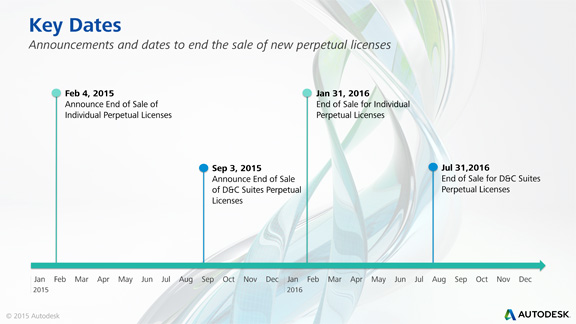
Key dates in Autodesk’s move to subscription licensing image courtesy of Autodesk).
Latest News
September 18, 2015
 Key dates in Autodesk’s move to subscription licensing image courtesy of Autodesk).
Key dates in Autodesk’s move to subscription licensing image courtesy of Autodesk).A week before Autodesk began publicizing its software suites’ migration toward subscription, Andrew Anagnost, Autodesk’s senior VP of industry strategy and marketing, began speaking to journalists to quell the misconceptions associated with the new licensing model.
The company is announcing that, “After July 31, 2016, new commercial licenses of most Autodesk Design & Creation Suites and individual products will be available by subscription only.”
Anagnost clarified that subscription software doesn’t necessarily mean cloud-hosted software. In the case of Autodesk PLM 360, the modules are accessible via a browser, but with many design creation and modeling titles like 3dx Max and Autodesk Inventor, the software is fully installed on the customer’s machine just like any other desktop software, but the subscription must be active for the customer to use the software.
The company has been nudging its customers toward the new licensing model throughout the last year, but the reminder makes clear to customers with long software acquisition cycles that the deadline is looming.
The shift to the cloud-friendly pay-as-you-go subscription model is expected to stir up some criticism from those who prefer perpetual desktop licenses—the way design and engineering software has traditionally been licensed.
With subscription, “Customers go from higher upfront cost to lower upfront cost,” Anagnost pointed out. “New customers love the flexibility of the model. They can buy the software for a month, three months, or a year; they can put three engineers on subscription for three months, but someone else for a year.”
In the old perpetual licensing model, buyers are required to pay a significant upfront cost for each seat, along with annual maintenance fee to gain access to regular upgrades. Autodesk expects firms with evolving projects and peak demands will find subscription licensing more attractive.
In the traditional perpetual desktop license, the permission to use the software is tied to a specific machine, Anagnost pointed out. “In the new subscription model, you can install the software anywhere—the laptop, the home PC, and the tablet. The right to use the software follows the user,” he said. “As we move forward, we’ll offer not only single user licensing but milti-user licensing option for subscription.”
He also confirmed that the subscription model doesn’t require a minimum term commitment; therefore, customers may sign up for as long as they need the software and cancel anytime they wish to. Autodesk offers one month, three months, annual, and multiyear subscriptions. Longer term subscriptions work out to lower month payments. For example, the Product Design Suite Premium is available for one-year subscription at $2,310 (works out to $192.50 per month), or one month subscription at $290 a month.
Anagnost emphasized that customers who have bought perpetual licenses and are on maintenance will continue to receive updates “for as long as they’re on maintenance.
Subscribe to our FREE magazine, FREE email newsletters or both!
Latest News
About the Author
Kenneth Wong is Digital Engineering’s resident blogger and senior editor. Email him at kennethwong@digitaleng.news or share your thoughts on this article at digitaleng.news/facebook.
Follow DE





